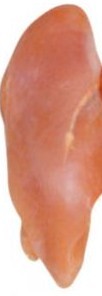 I couldn’t let the last day of National Chicken Month go by without sharing some random tidbits about our favorite feathered fowl. Here they are in no particular order.
I couldn’t let the last day of National Chicken Month go by without sharing some random tidbits about our favorite feathered fowl. Here they are in no particular order.
1. Skin Color
The color of a chicken’s skin, which can range from white to yellow, is directly related to the chicken’s diet and not necessarily an indicator of quality.
2. Free Range
Chickens are typically raised indoors in houses that can hold tens of thousands of birds. Free range birds are permitted to move about freely outdoors as much as they’d like. They’re also usually fed vegetarian diets, without antibiotics that are often added to chicken feed to speed up the birds’ growth so they’re ready to sell sooner.
3. Determining Doneness
Poultry should always be served fully cooked, until well-done. Because it becomes dry, tough and stringy when overcooked, it’s important to cook it just until it’s done and no longer. Here are a few ways to determine a chicken’s doneness:
1. Temperature – Chicken should be cooked until it’s 165°-170°. When using a thermometer, make sure to insert it in the thickest part of the meat, away from any bones.
2. Color of Juices – When a sharp knife is inserted into the chicken, any juices that run out should be clear in color, not pink.
3. Touch – Much like beef, chicken flesh will toughen up as it cooks. When touched, cooked chicken should spring back quickly.
4. How Long Can I Keep it
…in the freezer?
According to the USDA, if wrapped properly, a raw, whole chicken can be frozen for up to a year. Raw chicken parts can be frozen for up to 9 months. Cooked chicken should only stay in the freezer for up to 4 months.
…in the fridge?
Raw chicken, whole or parts, should not be refrigerated for more than 48 hours. Cooked chicken or leftovers should be eaten within that same timeframe.
If you have any questions about how to safely prepare, package, cook and store chicken or any foods, visit the USDA’s Food Safety Education website at: http://www.fsis.usda.gov/Food_Safety_Education/usda_meat_&_poultry_hotline/index.asp
 I got lucky twice in one day yesterday. I finally found time to check out the new MOM’s (My Organic Market) in my neighborhood (score) and while there I picked up my first blood oranges of the season. (Double score.)
I got lucky twice in one day yesterday. I finally found time to check out the new MOM’s (My Organic Market) in my neighborhood (score) and while there I picked up my first blood oranges of the season. (Double score.)





 You’ve seen them sharing space on grocery store shelves, both flaunting the name ‘milk’ on their labels, but neither tasting quite right in your Cheerios. Evaporated milk and sweetened condensed milk are both technically milk, with a few modifications.
You’ve seen them sharing space on grocery store shelves, both flaunting the name ‘milk’ on their labels, but neither tasting quite right in your Cheerios. Evaporated milk and sweetened condensed milk are both technically milk, with a few modifications. I’m teaching a knife skills class tonight at L’academie de Cuisine in Bethesda (www.lacademie.com) so I thought I’d share a few tips to keep you sharp in the kitchen.
I’m teaching a knife skills class tonight at L’academie de Cuisine in Bethesda (www.lacademie.com) so I thought I’d share a few tips to keep you sharp in the kitchen. I love a good surprise and I got one recently in the produce section – yellow watermelon. The bright yellow flesh caught my eye and into my reusable canvas grocery sack it went. The second surprise came later when I tasted my discovery. It tasted exactly the same as its red-fleshed cousin!
I love a good surprise and I got one recently in the produce section – yellow watermelon. The bright yellow flesh caught my eye and into my reusable canvas grocery sack it went. The second surprise came later when I tasted my discovery. It tasted exactly the same as its red-fleshed cousin! I couldn’t let the last day of National Chicken Month go by without sharing some random tidbits about our favorite feathered fowl. Here they are in no particular order.
I couldn’t let the last day of National Chicken Month go by without sharing some random tidbits about our favorite feathered fowl. Here they are in no particular order.
 It’s National Chicken Month and to celebrate, many of my posts over the next couple of weeks will focus on – you guessed it – chicken! First up, the difference between white and dark meat.
It’s National Chicken Month and to celebrate, many of my posts over the next couple of weeks will focus on – you guessed it – chicken! First up, the difference between white and dark meat.